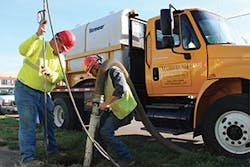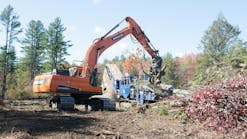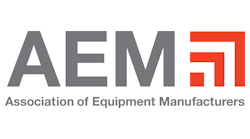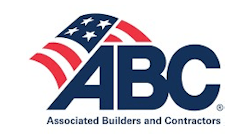Excavation for installs of underground utilities is standard procedure in nearly every country. However, concealing these services is about much more than simply hiding unsightly lines. Undergrounding can cross waterways, reduce wildlife and aviation hazards, reduce unlawful utility usage, and shrink the service footprint.
Our escalating dependency on the latest technology is unquestionably keeping underground contractors busy around the clock with new installs and efficiency upgrades. But for today’s workers, installing sensitive fiber optics and new gas and electrical lines is an unending dilemma of fighting with tight spaces, traffic, neighborhood aesthetics, and environmental policies. And then there is the additional challenge of working in an environment where at any given second, a surprise gas, water, or sewer line creates a safety nightmare.
Sensitive Subjects Uncovered Safely
Product manager Ben Schmitt of Vactor Inc. says of the 105-year-old company, “We have been supplying vacuum excavation solutions for our customers for a long time. Today, we have industry leading brands with specialized vacuum excavation solutions ideally suited to sensitive excavation projects.”
These brands include the Vactor 2100 Plus sewer cleaner and the Guzzler Guzzcavator, which is an industrial vacuum system. “The third system is our dedicated Vactor HXX vacuum excavator designed specifically for vacuum excavation.
Schmitt says that Vactor customers have different levels of use, “from the dedicated hydro excavator contractors where that’s all they do every day utilizing our full-size HXX product, or to utilities, utility contractors, general contractors, and municipalities who need to daylight certain utilities or other underground features as part of other applications.
“These customers can choose from Vactor’s expansive offering from the Paradigm, Prodigy, or mid-sized HXX product. Or, these customers can rent what they need through our larger dealer network that has over 100 locations throughout the US and Canada.”
He says that their hydro vac trucks are all supplied with Vactor’s line of HXXpose and Reveal nozzles specifically designed for the application to maximize productivity and safety.
Schmitt explains that the Vactor HXXpose 1/2-inch corrosion resistant nozzle has internal components made of tungsten carbide and housed in a corrosion resistant stainless-steel casing that will hold up in harsh conditions. To extend life, he says the nozzle can be renewed with Vactor rebuild kits.
When water is not an option or available, Schmitt suggests using air as the answer.
“It really depends on the surface material and your specific project. For example, in loose soils or sand, air can cut through to expose your utility with our 150-psi air compressor option. In tougher conditions, we offer a 250-psi air compressor option for increased cutting ability. Many subsurface utility engineering (SUE) applications require the locating of a buried utility where the hole is then backfilled. Utilizing air excavation is a great way to keep spoils dry and then re-used as immediate backfill.”
Although Vactor’s dedicated hydro excavators have been around for a few decades, the company is unveiling a new Vactor hydro excavator for 2018. Schmitt says this new truck excavator took three years of research and problem solving to achieve their goals in addressing the changes in the industry’s legal weight for payloads.
So far, feedback has been very positive; “People were surprised at the payload and how much we can carry as well as the other productivity and operational improvements,” he adds. The company focused on reducing overall weight but that alone was not enough to increase payload.
“The regulations stipulate only so much weight can be carried over each axle, so we moved the unit’s weight and debris body position, so now when the rear axle reached its limit, so did the front axle. Plus, we have implemented a lot of features such as onboard diagnostics, Bluetooth remote service connectivity, quieter and more powerful vacuum performance, and a longer-reaching boom to provide a much larger working coverage area.”
As safety is always a primary concern, Schmitt adds that, “Not only do we have a lot of serviceability features to make it get up and running quicker; our controls always have a second method to do a particular function. That way, if a button stops working, there’s a redundancy feature that allows you to operate it manually and still get the job done.”
The new onboard Bluetooth connectivity enables the operator to connect their truck to the service center via their phone. Then, in the event of a mechanical or electrical failure out on the job, the problem can be swiftly diagnosed.
Reinventing the Wheel
Damien Garreau, the North American product manager for France-based Marais Equipment, a Tesmec company, and now with a US manufacturing facility in Texas, says the excavation used to meet the demands of today’s technology infrastructure “is using techniques that are decades old.” This can cause a high impact on the areas being serviced: noise, traffic, pedestrian disruption; dirt and general inconvenience to dig, lay cable, haul away spoils, and fill in the site, Garreau observes. And it can be slow going at about 300 feet per day, he adds.
However, all these headaches can be eliminated with the Marais Cleanfast and Marais Sidecut SC3C—machines that Garreau says are perfect for minimally invasive trenching in dense, urban areas, and they are about three times faster than conventional trenching, “leaping production from 80 meters a day to more than a half mile a day.”
Marais microtrenching has been used for about seven years in the rest of the world and made its debut in the US only about a year ago, but Garreau says with the high cost-per-foot to install technology cables in urban infrastructure, “Using this machine just makes good economic sense for everyone.
“Once the machine cuts the narrow trench, you can attach a hose connector to any vac manufacturer or street sweeper to collect spoils as you go.”
Another good choice is the Marais Cleanfast unit, which he explains is a larger truck-mounted microtrencher that is essentially a “four-in-one machine.”
“This machine can achieve 2000 feet of trenching a day in the city and 4000 feet a day in a suburb, and it uses minimal equipment—one truck to trench and vac, and one roll-off truck.
“It’s pretty simple to operate these machines,” says Garreau, and adds that, “We can have a good contractor ready to go in less than a week, and with our Texas-based warehouse, customers can quickly get all kinds of spare parts and have accessible staff to answer any technical issues.”
The Best of All Worlds
Everyone is in favor of doing excavation work that’s easier on both your back and your budget. But it’s an axiom of the Ditch Witch organization that, “If you choose the safest technique, then your budget and your workers will benefit.”
“When you’re trying to expose a gas line, or electric utilities, or dig a trench in a tight area, hydro excavation is the way to go,” says Chapman Hancock, Ditch Witch product manager for vacuum excavation.
“Choosing hydro excavation has multiple benefits. And with these techniques—proven to be safe for exposing underground utilities—you are minimizing the chance of a disastrous strike, and thereby mitigating the financial stakes of having to shut down, repair, and replace that service equipment,” he says.
But in some situations, “Say you just need to daylight something, to put your eyes on a utility to mark location, for example, then using air is a perfect choice. When using air excavation, once your pothole is complete and utilities are located, you can take advantage of the dry spoils that were just excavated and put the spoils back in the hole, eliminating the additional need for backfill materials,” explains Hancock.
He adds that several years ago, the use of air was gaining ground in the excavation market, which prompted the Ditch Witch organization to switch gears and meet that demand.
“But when using an air vac truck, all you need to do is dig straight down, find your utility, flashlight it, and you can fill it right back in—such a better option and it makes much less of an impact on the environment as well.”
Describing how the units are available in multiple configurations, Hancock says that the trucks paired with trailers can give an overall footprint of 20 to 40 feet (truck-trailer combination) as the trailer options range from 12 feet to about 22 feet. The spoils debris tank size ranges from 500-gallon to 800-gallons tanks.
“One benefit of the vacuum excavation truck line is that without a trailer, the overall footprint is reduced. Choice of equipment is really dictated by each situation, the location, type of soil, and accessibility issues that challenge operators to perform the job required.”
A Century of Service Continues
In 1921, Joe McLaughlin developed the first replaceable coal drilling bits and founded McLaughlin Underground, a company that today marketing manager Jake Jeffords says “gained a market reputation of providing the ideal drilling machinery for all underground boring operations.”
He adds that the company’s vacuum excavation line took off in popularity about the same time as directional drilling in the late ’90s.
Then, in the early 2000s, he explains that Vermeer Corporation, an Iowa manufacturer of underground machinery, took interest in McLaughlin’s unique expertise in hydro excavation and underground capabilities. After becoming a shareholder, McLaughlin was purchased by Vermeer and is now wholly owned by them, “which is a great partnership of our combined knowledge and experience in the underground market,” says Jeffords.
He says their units fill a market need in both size and tank capacity for compact job sites “such as production potholing, fluid management in directional drilling, or setting power poles.”
“Our new ECO75 and VX75 lines offer a customer the choice between 500, 800, or a 1,200 spoil tank to match our higher 1200 cfm vacuum lower. These units also have an 8.0 gallon per minute (GPM) water pump with a maximum water pressure of 3000 psi. And you can customize both series by adding a sewer jet or air compressor to the vacuum excavator.”
Jeffords adds that there are “a ton of different applications.” The Ditch Witch hydro excavator truck-mounted and trailer-mounted models offer contractors or municipalities numerous options to help with both the identification of underground utilities and to help manage drilling fluid returns on horizontal directional drill projects.
“Using soft digging technology like air or water eliminates the risk of damage, and with the choices ranging from a small 25 hp gas engine and a 100 spoils tank, to a large PTO truck with a 3,000 gallon spoils tank, just about any underground utility excavation, in any location or weather condition, can be performed safely, efficiently, and effectively.”
This certainly underscores the McLaughlin company tagline, “Providing solutions since 1921.”









